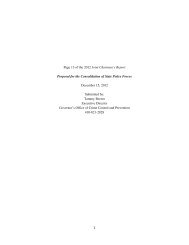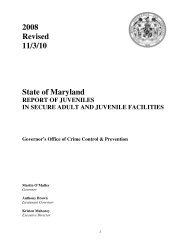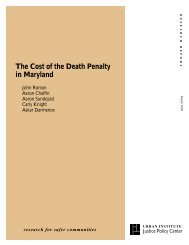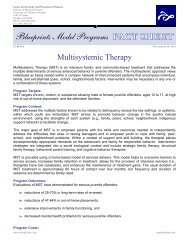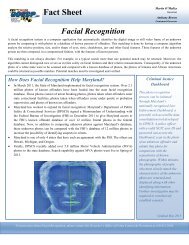Targeted Outreach - Governor's Office of Crime Control & Prevention ...
Targeted Outreach - Governor's Office of Crime Control & Prevention ...
Targeted Outreach - Governor's Office of Crime Control & Prevention ...
Create successful ePaper yourself
Turn your PDF publications into a flip-book with our unique Google optimized e-Paper software.
28 <strong>Targeted</strong> <strong>Outreach</strong><br />
Table 11<br />
Change in Reported Gang Membership Over a 12-Month Period<br />
Percentage <strong>of</strong> youth who: <strong>Prevention</strong> Intervention<br />
Comparison Target Overall Comparison Target Overall<br />
Join a Gang 8% 5% 7% 13% 12% 13%<br />
Stay in Gang 4% 4% 4% 11% 22% 17%<br />
Stay out <strong>of</strong> Gang 67% 62% 65% 49% 31% 39%<br />
Leave a Gang 21% 28% 24% 27% 34% 31%<br />
Total Number in Sample 188 204 392 45 58 103<br />
Note: There are no statistically significant differences among groups.<br />
• Less substance use with gang members,<br />
• Fewer number <strong>of</strong> delinquent behaviors overall,<br />
• Higher valuing <strong>of</strong> school,<br />
• Spending more time on homework, and<br />
• More positive family relationships.<br />
It is important to point out that increased levels <strong>of</strong><br />
participation did not have a negative effect for the<br />
14- to 18-year-olds; rather, there is no effect for more<br />
frequent attendance by the older group on these<br />
measures. What we do not know, however, is whether<br />
a duration <strong>of</strong> longer than one year in the program<br />
might have a positive effect for older youth on this<br />
set <strong>of</strong> outcomes as well. The negative behaviors displayed<br />
by older youth may be more entrenched in<br />
their lifestyle and may take longer than one year to<br />
significantly change.<br />
What Were the Effects on Gang<br />
Involvement?<br />
In the analyses discussed above, we examined<br />
whether participants are more or less likely than<br />
comparison youth to join or leave gangs; however, we<br />
found no differences between the two groups in<br />
those rates. We also found no relationship between<br />
how frequently the youth attend the Club and<br />
whether they join or leave a gang, although we did<br />
see differences in reductions <strong>of</strong> gang behaviors, as<br />
noted above.<br />
The rates <strong>of</strong> joining and leaving a gang, as well as<br />
remaining in a gang or out <strong>of</strong> a gang, for GPTTO<br />
and GITTO youth, versus their respective comparison<br />
groups, are illustrated in Table 11. Although we<br />
did not see a difference between participants and<br />
comparison youth on these specific variables, as<br />
noted earlier in this chapter we did find a reduction<br />
in gang and delinquent behaviors that may be important<br />
precursors to youth’s disengaging or dissociating<br />
entirely from their gang peers. This would be consistent<br />
with the goals <strong>of</strong> two <strong>of</strong> the intervention Clubs,<br />
where staff and collaborating agencies emphasized<br />
that they do not expect the youth to leave the gang,<br />
which could be dangerous, and because they are<br />
aligned in their neighborhoods with certain gangs<br />
for life. Rather, staff at these Clubs emphasized that<br />
they are striving to instill in youth more positive values<br />
and alternatives to the gang lifestyle.<br />
What Do These Results Tell Us?<br />
The findings reported in this section show the effects<br />
on youth’s lives <strong>of</strong> one year’s participation in GPTTO<br />
and GITTO. Taken together, these results provide an<br />
indication <strong>of</strong> the positive effect involvement in<br />
GPTTO and GITTO can have on youth. The findings<br />
are stronger for intervention youth than prevention<br />
youth. Being more effective among youth who<br />
already exhibit problem behaviors, namely gang association<br />
and delinquency, is surprising since youth<br />
programs are typically better at deterring the initiation<br />
<strong>of</strong> bad behavior than changing an established<br />
pattern. However, the GITTO projects had been in<br />
existence longer and therefore had more time to<br />
develop their programs and intervention strategies;<br />
whereas the GPTTO Clubs were only in their second<br />
year <strong>of</strong> implementation. Further, it may have helped<br />
that the target youth identified for GITTO fit a more<br />
narrowly defined range <strong>of</strong> youth and, therefore, the<br />
intervention can take a more focused approach.



